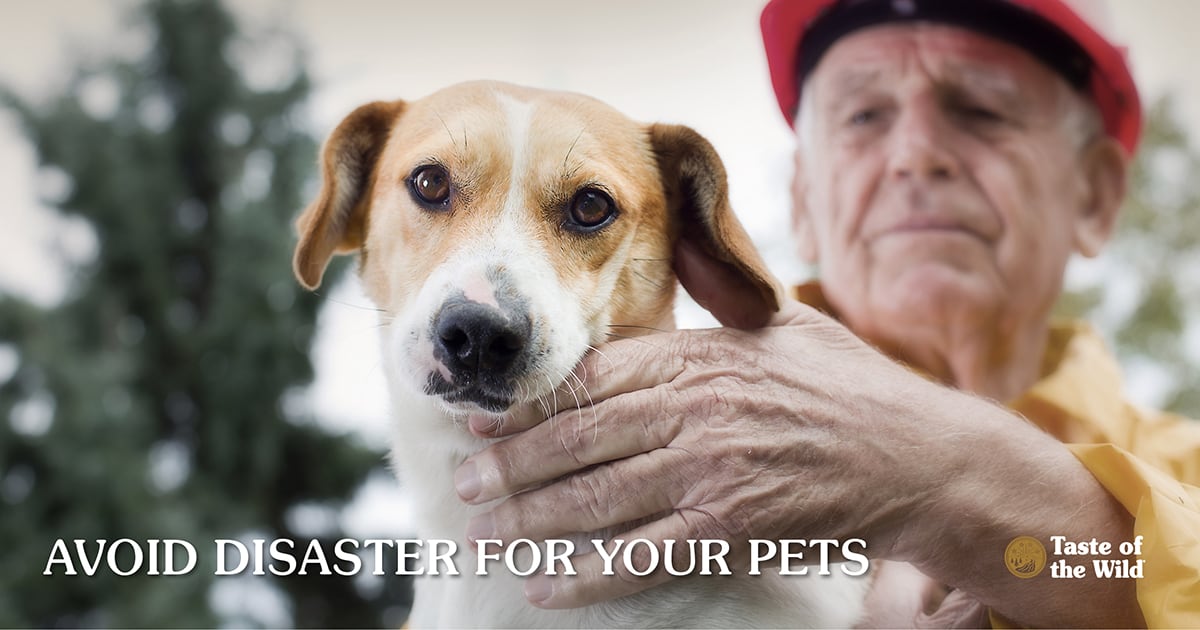
You don’t even want to think about it. But fires, tornadoes, floods, earthquakes and other natural disasters do happen, and you need to think ahead to protect your family. But be sure to make those forward-thinking thoughts include your pets. What if you need to evacuate? Many evacuation shelters can’t take pets, and you don’t want to leave them behind. To help protect your pets when the worst happens, here are some tips for your pet emergency plan.
Keep your pet’s identification current at all times.
It’s easy for pets to escape or get lost when disaster strikes. Make sure your pet has a collar and ID tag that includes your current cell phone number. Since collars can fall off, a microchip provides a more permanent form of identification. Check with the microchip supplier to ensure the contact information is current and ask your veterinarian to scan the chip to make sure it’s still working.
Post a “Pets Inside” sticker on your front door.
In the event of a fire or other house emergency, this alerts fire fighters or rescue workers to how many dogs and cats may need to be rescued from your home.
Save all of your pet’s health information in one place.
If you need to temporarily board your pet or if they need medical care, it pays to have a pet health app on your smartphone. That way, you can instantly access your pet’s vaccine history, health records, prescriptions, pet health insurance information, microchip number and emergency clinic phone numbers instead of scrambling to find them during an emergency.
Of course, in the event of a power outage, having that information in paper form, in a waterproof bag, will come in handy, too.
Keep a recent photo of your pet on hand.
If you need to post lost pet notices on the internet or just want to blanket the area with posters, a picture of your pet may help get them back to you.
Have a crate or carrier for each pet.
The safest way to transport a pet is in a carrier that’s been secured inside the car to prevent it from sliding around. Since your pet may need to spend some time in the crate, make sure it’s big enough for them to stand up and turn around inside. Line carriers with comfy blankets and toss treats and toys inside. Leave the crate open in your house so your pet can explore and feel comfortable being inside before you need to hit the road.
Know the boarding facilities in your area.
If you can’t keep your pets with you, know boarding facilities, shelters or pet-friendly hotels that could take your pet in an emergency. Or talk to friends who would be willing to temporarily house your family, including the furry members.
Prepare a pet disaster kit.
You’ll want at least a week’s supply of food and bottled water for each pet as well as food and water bowls. If your pet eats canned food, don’t forget a manual can opener. If your pet is on regular medication including parasite prevention, make sure to include those. Pets of the feline persuasion will need a litter box, litter, a scoop and plastic garbage bags, and dogs will require plastic waste bags. Don’t forget to include halters and leashes, too.
Pack a pet first aid kit.
This should include sterile gauze pads and gauze rolls, self-adhering bandages, a rectal thermometer and petroleum jelly for lubrication, disposable gloves, sterile saline solution, tweezers, hydrogen peroxide, scissors with rounded ends and first aid instructions. It also helps to include a muzzle or cloth strips to help prevent injured pets from biting, but these should only be used if your pets aren’t vomiting or having difficulty breathing.
With any luck, you’ll never have to deal with a natural disaster. But if you do, at least you can feel better that you’ve made plans to keep your whole family safe, including your pets.
RELATED POST: Protecting Your Tiny Buddy
The information in this blog has been developed with our veterinarian and is designed to help educate pet parents. If you have questions or concerns about your pet's health or nutrition, please talk with your veterinarian.
